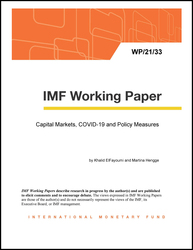
Capital Markets, COVID-19 and Policy Measures
Capital Markets, COVID-19 and Policy Measures
READ MORE...
Volume/Issue:
Volume 2021
Issue 033
Publication date: February 2021
ISBN: 9781513569413
$18.00
Add to Cart by clicking price of the language and format you'd like to purchase
Available Languages and Formats
| English |
Prices in red indicate formats that are not yet available but are forthcoming.
Topics covered in this book
This title contains information about the following subjects.
Click on a subject if you would like to see other titles with the same subjects.
Banks and Banking , Economics- Macroeconomics , Money and Monetary Policy , Capital flows , Lockdown policy , Fiscal policy , Monetary policy , Pull factors , Emerging markets , WP , portfolio flow , Covid case , policy measure , infection shock , monetary policy action , trade openness
Summary
The COVID-19 pandemic and associated policy responses triggered a historically large wave of capital reallocation between markets and asset classes. Using high-frequency country-level data, this paper examines if and how the number of COVID cases, the stringency of the lockdown, and the fiscal and monetary policy response determined the dynamics of portfolio flows. Despite more dominant global factors, we find that these domestic factors played an important role, particularly for emerging markets and bond flows, contributing to a global wave of reallocation to safer asset classes. Our results indicate that rising domestic COVID cases had a strong positive effect on portfolio flows, which responded to an increase in financing needs in affected economies. Lockdown and fiscal policy measures also led to an increase in portfolio flows; however, evidence from the CDS market suggests that the increase in flows was dominated by supply forces, reflecting investors' preference for stronger policy responses. In contrast, we find that interest rate cuts led to a decline in portfolio flows as investors searched for higher yield. Finally, we show that COVID policy responses also affected countries' exposure to the global shock and that pre-COVID macroeconomic conditions, such as lower sovereign risk and higher trade openness, contributed to larger flows during the COVID episode.
Copyright © 2010 - 2025
Powered by:
AIDC



